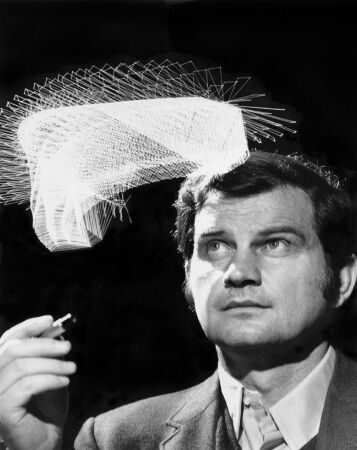
Sine Curve Man © Charles Csuri
Charles Csuri, whose 1960s computer experiments cemented his place in the history of digital art, has died at the age of 99. Csuri died on Sunday, according to an announcement from Ohio State University in Columbus, where he had been a professor of art education and computer science for many years. Csuri's work has been described as unclassifiable—not creative enough to be classified as art, nor digitally oriented enough to be classified as the material of the tech world. Despite the difficulties he recounted throughout his career, Csuri attracted supporters for the unique manner in which he combined conventional art methods like painting with algorithms, computing, and other technologies. Historians dubbed him the "father of computer art" in several works, while Csuri described himself as "the first artist with any significant art qualifications to work with the computer" in a 1998 New York Times profile.
Csuri's place in the history of digital art is practically undisputed, despite the fact that he has never been the focus of a meaningful exhibition at a major museum. Hummingbird (1968), a computer-generated animation of a bird whose picture appears to double and come apart, is one of his most well-known works. The film, which is made up of over 30,000 separate shots, was created using a time-consuming process that included having an IBM 704 computer create photos of the hummingbird. Each image included data for a drum plotter, which converted each image into a pen drawing as it was sent through it. Hummingbird was one of the first works of its sort to join the Museum of Modern Art's holdings, having been commissioned for a series of computer-generated videos supporting the display "The Machine as Seen at the End of the Mechanical Age." In her genre-defining 2003 book Digital Art, art historian Christiane Paul termed the video a "landmark of computer-generated 'animation.'"
Despite his notoriety in specific creative circles, Csuri maintained that few people were aware of his significance. Indeed, Hummingbird is the only Csuri work held by MoMA. Csuri told the New York Times in 1995, "I think I'm a darn fine artist, and I don't think many people know it."
Charles Csuri was born in West Virginia on July 4, 1922. Later, he attended Ohio State University and was placed on a path to becoming a professional football player. He was drafted by the Chicago Cardinals in the NFL draft in 1944, despite declining the option to serve in the US Army during WWII. He was exposed to mathematics, algebra, and technology during the war, which he would later use as a professional artist. He began teaching at OSU in 1947, and for a time, he shared an office with Roy Lichtenstein, the Pop artist who would later become famous for his Pop paintings incorporating what appeared to be Ben-Day dots. Csuri was working in a more traditional approach at the time, creating abstracting canvases that would subsequently be included in the Venice Biennale. That all changed in 1964, when he saw a computer-generated portrait published in an OSU newspaper. He enrolled in a programming class and started creating his own computer art. Later, he would have others perform the programming for him, emphasizing that he saw himself as an artist first and foremost.
 © Charles Csuri
© Charles Csuri
Csuri's early work, which includes warped-looking portraits made from sine waves and a computer-generated series of photographs depicting a person's aging, may appear to be wholly digital. In fact, he saw it as a natural extension of what he was already doing with paint. He went on to further stress that idea when, in the 1990s, he began to create pieces that used bump mapping (a sort of imaging that detects changes in texture on a surface) to digitally visualize abstractions. Gossip (1987–91), for example, involved scanning a picture and then reconstructing it in a digital void, resulting in an array of multicolored forms that disintegrate into ribbons. The Ars Electronica festival in Linz, Austria, awarded it a $100,000 prize of distinction. In 1998, Siggraph, the International Computer Graphics Conference, conducted a retrospective honoring late-career achievements. Csuri was "ahead of his time," according to curator Barbara London, who fought for video and sound art as important mediums at the Museum of Modern Art. "The stress that I often experience as an artist is my desire to break out from this meticulously measured cosmos, a universe where the consequence is foreseeable," Csuri wrote in the exhibition book. "Creativity becomes a process of discovery when I allow myself to play and search in the zone of uncertainty." "The better the product, the more childlike and fascinated I get about this universe and space full of items."


 Jean Dubreil
Jean Dubreil